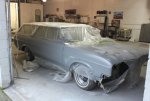The first *genuine* reason for child safety seats!
Dear Dr. Frankenbuick and Bob Mando, :shield:
Well, never had kids and given how screwed up our world has gotten . . . I have to conclude that's just as well. Because . . . . .
The pathetic truth is that ONLY with your turbo going at full bore do the kids really need the child safety seats that are required nowadays!
*Sigh* nope, the Internet isn't very safe either. Sure wish we would not only restore these old cars but also the innocent world from which they came . . . . . .
Oh well, at least we can dream can't we? :bgrin:
Cheers, Edouard :beers:
Dear Dr. Frankenbuick and Bob Mando, :shield:
Well, never had kids and given how screwed up our world has gotten . . . I have to conclude that's just as well. Because . . . . .
No worries: class three hitch, secure the doors and china in the trailer and make sure the dog stays to the back. Then buckle-up kids, we are going on vacation! :car:
The pathetic truth is that ONLY with your turbo going at full bore do the kids really need the child safety seats that are required nowadays!
you guys might want to take note that my antivirus software is tripping out when i go to access that page. says i'm being attacked by the Blackhole Exploit Kit.
*Sigh* nope, the Internet isn't very safe either. Sure wish we would not only restore these old cars but also the innocent world from which they came . . . . . .
Oh well, at least we can dream can't we? :bgrin:
Cheers, Edouard :beers:



